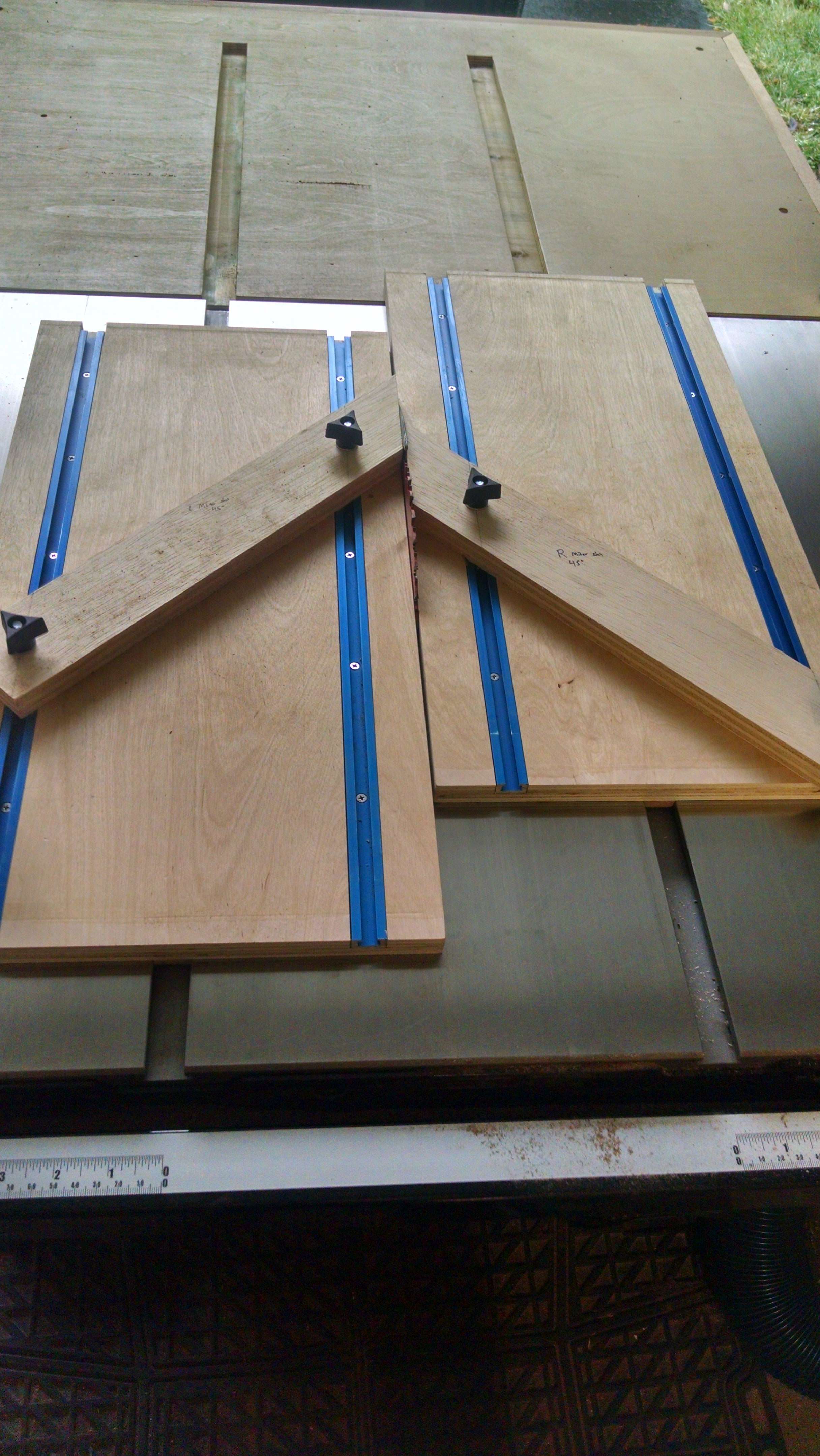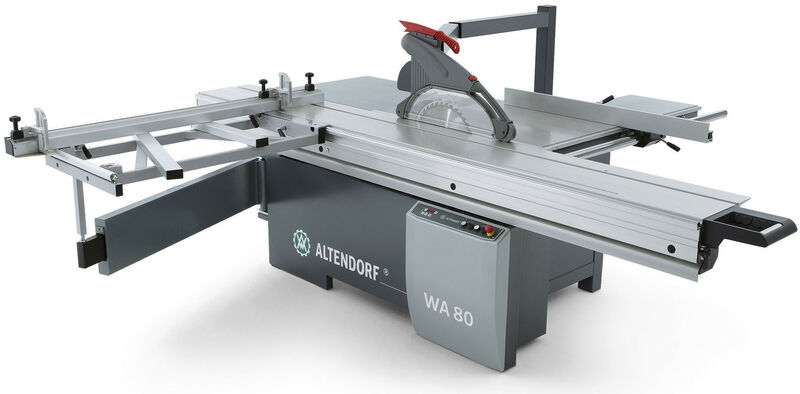Steve Maskery
Established Member
I don't often have to do cross-cutting operations on the tablesaw, as I have the big Bosch Axi-Glide SCMS, but there are some times when the TS is better suited. Although the SCMS does have a depth limiter, it is not excellent, the saw bounces somewhat, and when the blade depth is restricted, the saw cut no longer goes back to the far edge of the workpiece. It's far from ideal.
I'm making a set of M&T joints at the mo. The cheeks are sorted, thanks to The Ultimate Tablesaw Tenon Jig, so now I have the shoulders to cut. It's much cleaner to do this on the TS rather than the SCMS for all the reasons mentioned above.
My saw came with a very basic mitre fence. Robust, firm and actually very accurate, but it's a bit primitive. Yes I can (and do) attach a scrap sub-fence and I can (and do) clamp a stop to that. But we can do so much better.
Long, long ago in a land far away, and in another life before I had a SCMS at all, I made a traditional crosscut sled. 1/2" ply base, fences fore and aft. Even in those days I was fairly safety conscious, so it has a drop-over blade cover and tunnel guard at the back, where my thumbs are. It was OK. It still hangs on the wall, even though the runner no longer fits the mitre slot very well. 2 years in a barn didn't do it any favours.

But it was only OK. There is no way of fastening anything down to the base, I can't do angled cuts on anything over about a foot or so long and it doesn't take long for the zero-clearance slot to wear, resulting in an inferior quality of cut.
So my criteria for its successor are:
It should be zero-clearance and be able to be kept zero-clearace.
I must be able to clamp the workpiece down if necessary.
Any fence should be able to be set with perfect accuracy, at any angle.
My guarding must not be compromised.
A couple of years ago I bought a load of T-track from Rutlands. It was on offer, so I filled my boots. It's been sitting in the corner ever since waiting for me to get round to this. So I found a piece of mahogany and planed it to be a Goldilocks fit in the mitre slot:

I then screwed down a piece of 9mm MRMDF to it

It's not easy to see in the picture above (and not just because it is way out of focus...) that there is a gap of about an inch between the blade and the edge of the board. That gap will be taken up by a replaceable, sacrificial strip.
I first routed a suitable rebate on the RT:

Then I screwed it over the edge from below:

This now makes the whole thing a bit wider than it needs to be, so it is trimmed with the same blade that I entend to use for the job, making it zero-clearance:

My first idea was to have a grid of T-track, all perfectly mitred. This is easier said than done. I did cut all the pieces, using an angle grinder

then cleaned up the sawn faces with a disk sander on my lathe and then a diamond file:

I appear to be having some problems focusing this week

I started to lay out the pieces, but being all hand-finished, it soon became apparent that it was going to look awful, so I cut of all the mitres and started again, this time leaving a square hole at each imtersection. This is easier, neater, and will give me the option to drop in a fastener even if the edge of the slot is obstructed. I'm using double-sided carpet tape. "Why not glue?" I hear you ask. Well the problem with gluing this is that these layers of MDF are of different thicknesses, 9mm for the base and 12mm for the infills. A glue line that is unbalanced can cause the MDF to bow. I have a shooting board to which this has happened and I'm sure that this is the reason. I am hoping that this way, the board will stay pretty flat. We shall have to see.
Incidentally, the MDF is 12mm the T-track is 1/2". The T-track should be a gnat higher than the MDF, and, indeed, it some places it is. In other places they are dead flush. I assume that the MDF doesn't have such tight tolerances. Thats OK. I want to clamp down to the T-Track, but not the MDF. If the MDF were proud then any clamping would tend to pull the T-track up and away from the base. I don't want that to happen.
So after quite a lot of messing about, I've ended up with this

I hope it is going to be good, I've used 3-and-a-bit lengths of track, it's not going to be as cheap to replace.
The next job will be to make a fence for it.
I'm making a set of M&T joints at the mo. The cheeks are sorted, thanks to The Ultimate Tablesaw Tenon Jig, so now I have the shoulders to cut. It's much cleaner to do this on the TS rather than the SCMS for all the reasons mentioned above.
My saw came with a very basic mitre fence. Robust, firm and actually very accurate, but it's a bit primitive. Yes I can (and do) attach a scrap sub-fence and I can (and do) clamp a stop to that. But we can do so much better.
Long, long ago in a land far away, and in another life before I had a SCMS at all, I made a traditional crosscut sled. 1/2" ply base, fences fore and aft. Even in those days I was fairly safety conscious, so it has a drop-over blade cover and tunnel guard at the back, where my thumbs are. It was OK. It still hangs on the wall, even though the runner no longer fits the mitre slot very well. 2 years in a barn didn't do it any favours.

But it was only OK. There is no way of fastening anything down to the base, I can't do angled cuts on anything over about a foot or so long and it doesn't take long for the zero-clearance slot to wear, resulting in an inferior quality of cut.
So my criteria for its successor are:
It should be zero-clearance and be able to be kept zero-clearace.
I must be able to clamp the workpiece down if necessary.
Any fence should be able to be set with perfect accuracy, at any angle.
My guarding must not be compromised.
A couple of years ago I bought a load of T-track from Rutlands. It was on offer, so I filled my boots. It's been sitting in the corner ever since waiting for me to get round to this. So I found a piece of mahogany and planed it to be a Goldilocks fit in the mitre slot:

I then screwed down a piece of 9mm MRMDF to it

It's not easy to see in the picture above (and not just because it is way out of focus...) that there is a gap of about an inch between the blade and the edge of the board. That gap will be taken up by a replaceable, sacrificial strip.
I first routed a suitable rebate on the RT:

Then I screwed it over the edge from below:

This now makes the whole thing a bit wider than it needs to be, so it is trimmed with the same blade that I entend to use for the job, making it zero-clearance:

My first idea was to have a grid of T-track, all perfectly mitred. This is easier said than done. I did cut all the pieces, using an angle grinder

then cleaned up the sawn faces with a disk sander on my lathe and then a diamond file:

I appear to be having some problems focusing this week

I started to lay out the pieces, but being all hand-finished, it soon became apparent that it was going to look awful, so I cut of all the mitres and started again, this time leaving a square hole at each imtersection. This is easier, neater, and will give me the option to drop in a fastener even if the edge of the slot is obstructed. I'm using double-sided carpet tape. "Why not glue?" I hear you ask. Well the problem with gluing this is that these layers of MDF are of different thicknesses, 9mm for the base and 12mm for the infills. A glue line that is unbalanced can cause the MDF to bow. I have a shooting board to which this has happened and I'm sure that this is the reason. I am hoping that this way, the board will stay pretty flat. We shall have to see.
Incidentally, the MDF is 12mm the T-track is 1/2". The T-track should be a gnat higher than the MDF, and, indeed, it some places it is. In other places they are dead flush. I assume that the MDF doesn't have such tight tolerances. Thats OK. I want to clamp down to the T-Track, but not the MDF. If the MDF were proud then any clamping would tend to pull the T-track up and away from the base. I don't want that to happen.
So after quite a lot of messing about, I've ended up with this

I hope it is going to be good, I've used 3-and-a-bit lengths of track, it's not going to be as cheap to replace.
The next job will be to make a fence for it.













































